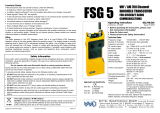iv
SAFETY TRAINING INFORMATION ............................................... i
FOREWORD ................................................................................... ii
IMPORTANT .................................................................................... ii
EXPLICIT DEFINITIONS ................................................................. ii
SUPPLIED ACCESSORIES ............................................................ ii
PRECAUTIONS............................................................................... iii
TABLE OF CONTENTS ................................................................. iv
1 PANEL DESCRIPTION ........................................................ 1 – 6
■Panel description ................................................................... 1
■Function display ..................................................................... 5
2 ACCESSORY ATTACHMENT .................................................. 7
3 BASIC OPERATION .......................................................... 8 – 11
■Setting a frequency ................................................................ 8
■Setting a squelch level ........................................................... 8
■Selecting a weather channel................................................... 8
■Receiving ............................................................................... 9
■Transmitting ........................................................................... 9
■ANL function ........................................................................... 9
■Low battery indicator ............................................................ 10
■Recall function ..................................................................... 10
■Setting weather alert function................................................ 11
■Accessing 121.5 MHz emergency frequency ....................... 11
■Lock function ........................................................................ 11
■Side tone function ................................................................ 11
■Setting beep tone ................................................................. 11
■Backlighting .......................................................................... 11
4 MEMORY OPERATION ................................................... 12 – 15
■Memory channel selection ................................................... 12
■Transferring memory contents ............................................. 12
■Programming a memory channel ......................................... 13
■Memory names .................................................................... 14
■Clearing the memory contents ............................................. 14
5 SCAN OPERATION ......................................................... 16 – 17
■Scan types ........................................................................... 16
■COM band scan ................................................................... 16
■Memory scan ....................................................................... 16
■Weather channel scan (U.S.A. version only) ............................ 17
■“TAG” channels ................................................................... 17
6 VOR NAVIGATION (IC-A24 only) .................................... 18 – 24
■VOR indications ................................................................... 18
■VOR functions ...................................................................... 19
■Flying to a VOR station ........................................................ 20
■Entering a desired course .................................................... 22
■Crosschecking position ........................................................ 22
■Duplex operation (U.S.A. version only) .................................... 24
7 BATTERY PACKS ........................................................... 25 – 27
■Battery charging ................................................................... 25
■Battery cautions ................................................................... 25
■Optional battery case ........................................................... 26
■Optional battery chargers ..................................................... 27
8 CLONING ................................................................................ 28
9 TROUBLESHOOTING ............................................................ 29
10 SPECIFICATIONS .................................................................. 30
11 OPTIONS ................................................................................ 31
12 QUICK REFERENCE ...................................................... 32 – 33
13 OPTIONAL HEADSET CONNECTION .................................. 34
TABLE OF CONTENTS






















